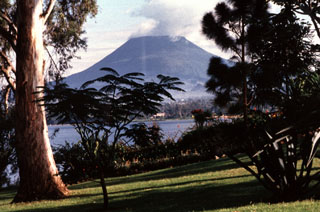Report on Nyiragongo (DR Congo) — October 2023
Bulletin of the Global Volcanism Network, vol. 48, no. 10 (October 2023)
Managing Editor: Edward Venzke.
Research and preparation by Berger.
Nyiragongo (DR Congo) Ongoing lava lake activity in the summit crater through September 2023
Please cite this report as:
Global Volcanism Program, 2023. Report on Nyiragongo (DR Congo) (Venzke, E., ed.). Bulletin of the Global Volcanism Network, 48:10. Smithsonian Institution.
Nyiragongo
DR Congo
1.52°S, 29.25°E; summit elev. 3470 m
All times are local (unless otherwise noted)
Nyiragongo is within the Albertine Rift Zone along the western branch of the East African Rift System in the Democratic Republic of the Congo. A lava lake inside the 1.2 km summit crater has been active since at least 1971. Eruptions during the last 120 years have been associated primarily with the summit crater, but several flank lava flows have also been observed as recently as 2019 and 2021, with the latter reaching the city of Goma (15 km S) (BGVN 46:06). Besides lava extrusions, activity has included incandescence, gas and steam emissions, and seismicity. The current report summarizes data between April and September 2023 and is based on occasional communications from the Observatoire Volcanologique de Goma (OVG) and satellite data.
During the reporting period, volcanic activity was relatively low and confined to the persistent lava lake. OVG reported that the eruption continued as normal from 27 May to 11 June, with crater incandescence observed at 1900 on 4 June and 1800 on 10 June. SO2 emissions were low. A subsequent OVG report indicated that activity continued low during 17-24 September. A diffuse sulfur dioxide plume with an estimated mass of 20 tons was identified in satellite data on 25 September.
The MIROVA (Middle InfraRed Observation of Volcanic Activity) hotspot system recorded a surge of moderate to high-power hotspots in about the second week of June 2023, and then frequent hotspots throughout July, and a few scattered hotspots in August. The MODIS-MODVOLC thermal alerts system recorded hotspots only on 3 April, 10 July, and 24, 25, and 27 July (two pixels each day in July). Sentinel-2 satellites recorded lava effusion in the summit crater during the few satellite observation days of the reporting period, corresponding to the elevated thermal observations (figure 97).
Geological Summary. The Nyiragongo stratovolcano contained a lava lake in its deep summit crater that was active for half a century before draining catastrophically through its outer flanks in 1977. The steep slopes contrast to the low profile of its neighboring shield volcano, Nyamuragira. Benches in the steep-walled, 1.2-km-wide summit crater mark levels of former lava lakes, which have been observed since the late-19th century. Two older stratovolcanoes, Baruta and Shaheru, are partially overlapped by Nyiragongo on the north and south. About 100 cones are located primarily along radial fissures south of Shaheru, east of the summit, and along a NE-SW zone extending as far as Lake Kivu. Many cones are buried by voluminous lava flows that extend long distances down the flanks, which is characterized by the eruption of foiditic rocks. The extremely fluid 1977 lava flows caused many fatalities, as did lava flows that inundated portions of the major city of Goma in January 2002.
Information Contacts: Observatoire Volcanologique de Goma (OVG), Departement de Geophysique, Centre de Recherche en Sciences Naturelles, Lwiro, D.S. Bukavu, DR Congo; MIROVA (Middle InfraRed Observation of Volcanic Activity), a collaborative project between the Universities of Turin and Florence (Italy) supported by the Centre for Volcanic Risk of the Italian Civil Protection Department (URL: http://www.mirovaweb.it/); Hawai'i Institute of Geophysics and Planetology (HIGP) - MODVOLC Thermal Alerts System, School of Ocean and Earth Science and Technology (SOEST), Univ. of Hawai'i, 2525 Correa Road, Honolulu, HI 96822, USA (URL: http://modis.higp.hawaii.edu/); Copernicus Browser, Copernicus Data Space Ecosystem, European Space Agency (URL: https://dataspace.copernicus.eu/browser/).


